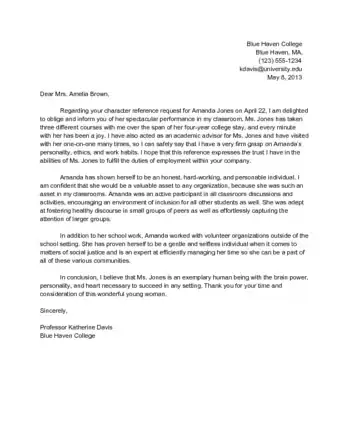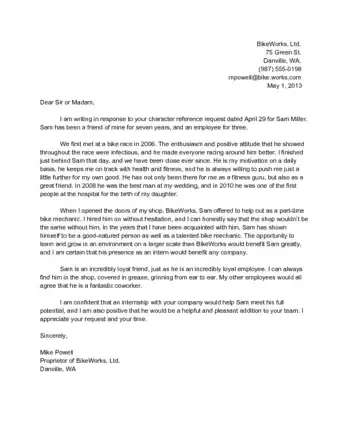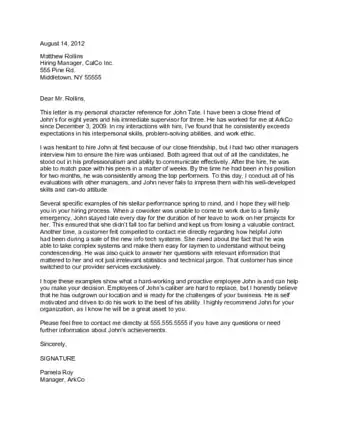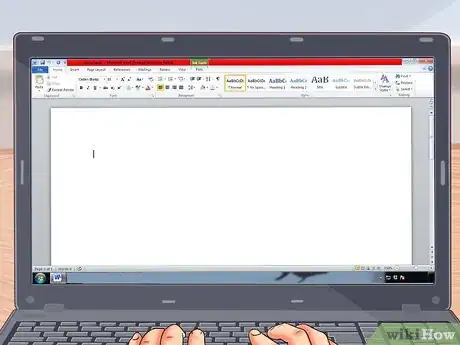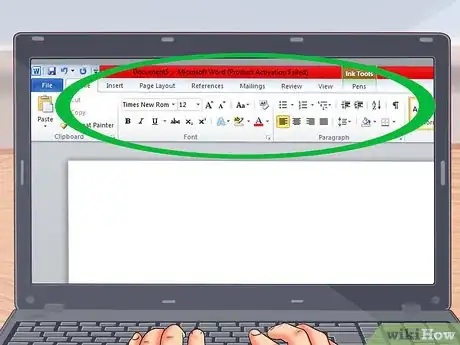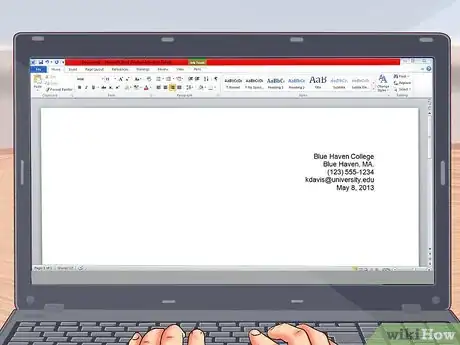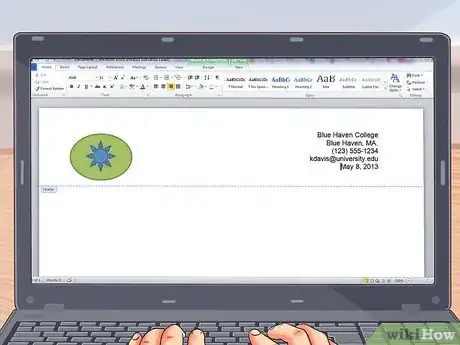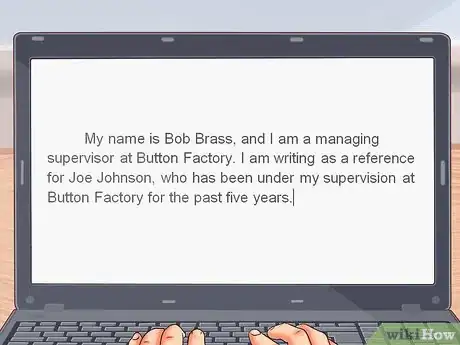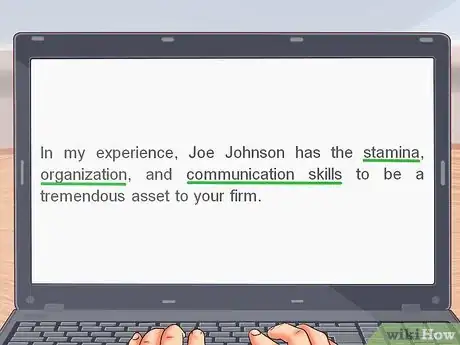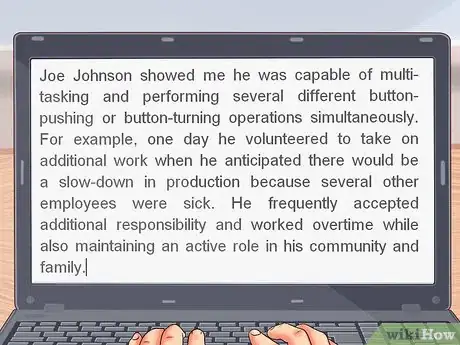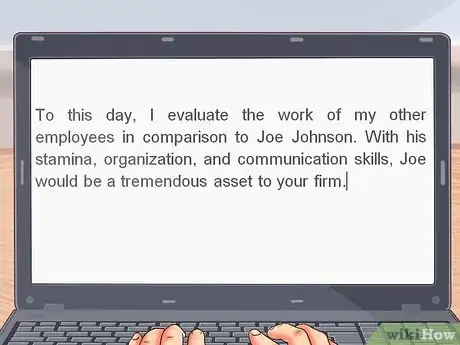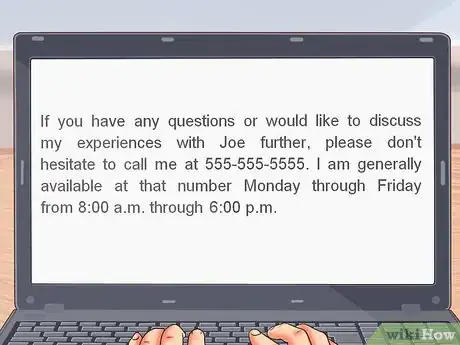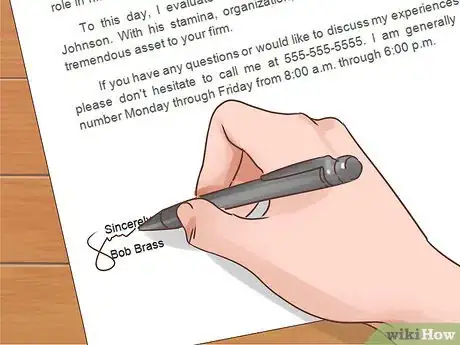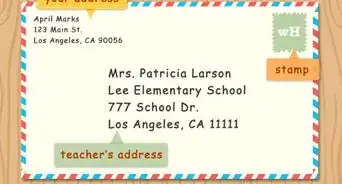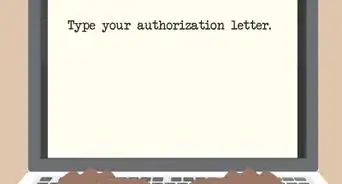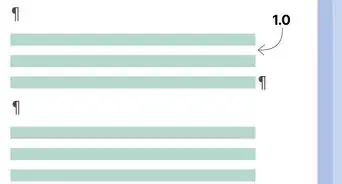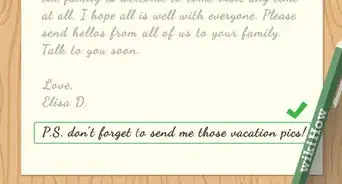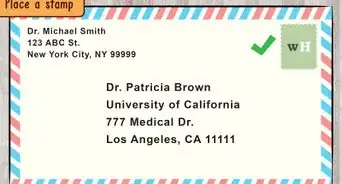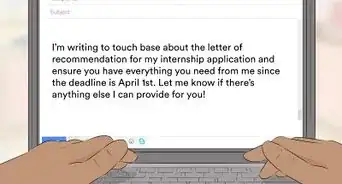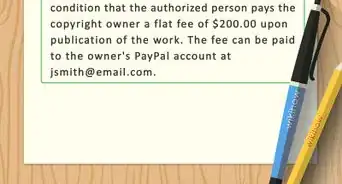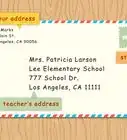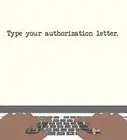This article was co-authored by Alyson Garrido, PCC and by wikiHow staff writer, Jennifer Mueller, JD. Alyson Garrido is an International Coach Federation accredited Professional Certified Coach (PCC), Facilitator, and Speaker. Using a strengths-based approach, she supports her clients with job search and career advancement. Alyson provides coaching for career direction, interview preparation, salary negotiation, and performance reviews as well as customized communication and leadership strategies. She is a Founding Partner of the Systemic Coach Academy of New Zealand.
wikiHow marks an article as reader-approved once it receives enough positive feedback. In this case, 100% of readers who voted found the article helpful, earning it our reader-approved status.
This article has been viewed 425,394 times.
If you are in a supervisory position, whether at work, school, or within a nonprofit organization as a volunteer, you may be asked to write a reference letter for someone. People often need reference letters when they are applying for a job or seeking admission to a particular school or course of study. Your reference letter should be formal in both format and tone, and describe the positive characteristics or skills that the candidate brings to their work.[1] [2]
Steps
Sample Reference Letters
Formatting the Reference Letter
-
1Type your letter using a word-processing application. Although it may seem more personal to write your letter by hand, typing it is more professional. A type-written letter also will be easier for the recipient to read.[3]
- Use a word processing application rather than the basic text application on your computer. Basic text apps lack the formatting options you'll need for your letter.
- If the candidate tells you the letter should be submitted through email, you still should type out a separate letter and attach it to your email as a PDF after hand-signing it, rather than simply typing your letter in the body of the email.
-
2Find a business letter template. The word-processing application you use typically will have templates available that will allow you to easily format your letter. A traditional business letter template comes with pre-set margins and settings so you don't have to do this manually.[4]
- Most word processing applications have several letter templates. Choose the formal business letter template, not one for a casual or personal letter.
- Use a standard, readable font such as Times New Roman or Helvetica.
- Typically the body of the letter will be set up so there is a double-space between paragraphs with no indentation. If you choose to indent your paragraphs, there's no need to double space between them.
Advertisement -
3Enter names and addresses. On the top of the first page of the letter, you'll type your name and address in the top right-hand corner of the page. The name and address of the recipient follows on the left side of the page.[5]
- You also should include any additional contact information, such as your direct phone number or email address.
- If you have letterhead that includes your contact information, there typically is no need to include your name and address a second time. However, you should include it if your letterhead refers to your employer as a whole and not you personally.
- Following the addresses, there will be a line for the date. Depending on the template you use, there also may be a subject line. For the subject, you can simply state "Reference Letter for" with the name of the candidate.
- In most cases you want to address the letter to a specific person. If the letter will be reviewed by several people, address it simply to "hiring committee" or "admissions committee." Speak to the candidate to find out what address is appropriate.
-
4Use letterhead if you have it. If your employer has letterhead, or if you have personal letterhead, it will make the letter look more professional. Regardless, make sure you have high-quality paper to print the letter.[6]
- The presentation of the letter reflects on you as well as the candidate. For this reason, you want it to look as formal and professional as possible.
- Plain white paper is fine. Stay away from cheap copy paper. You can find good letter-writing stock at any office supply store and at most large discount stores.
-
5Create a basic outline. Generally, it's a good idea to organize your thoughts about the candidate before you sit down to write your letter. Brainstorm qualities you want to include, and select the strongest of them for your letter.[7] [8]
- Keep in mind that your letter typically should be no more than one page long. Academic reference letters may extend to two pages.
- This gives you room for about three short paragraphs in the body of your letter. Because space is at a premium, you need to be able to write efficiently so that every word counts.
Drafting the Reference Letter
-
1Introduce both yourself and the candidate. Your letter will open with a line that begins "Dear" followed by the name of the person who will receive the letter. Then your opening sentences will provide your name, the name of the candidate, and the reason for your letter.[9] [10]
- Explain your relationship to the candidate and how long you've known them. If you have any special qualifications that make your reference more valuable, you should include those as well.
- Confirm details that are relevant to the candidate's application.[11] If you've been their supervisor at work, you'll want to state the company where you've worked and your position, as well as their position (if relevant), how long they've worked at the company, and how long you've supervised them.
- For example, you might write "My name is Bob Brass, and I am a managing supervisor at Button Factory. I am writing as a reference for Joe Johnson, who has been under my supervision at Button Factory for the past five years."
-
2List at least three exceptional skills or traits the candidate has. Immediately after your introduction, include a sentence that lists the skills or traits you will discuss in greater detail in the body of the letter.[12] These skills should be ones that are relevant to whatever position the candidate is applying for, so you might want to ask the person what you should be highlighting about them.
- The type of skills or traits you include here depends both on your relationship to the candidate and the purpose for your letter. Character reference letters should focus exclusively on character traits, while employment reference letters should focus on particular skills the candidate has that make them a good fit for that particular job.
- Academic reference letters are to some degree a hybrid of these two types of letters. In addition to skills that make the candidate well-suited to that particular course of study, you also might include character traits, such as their intelligence or their inquisitive nature.
- This should be the last sentence of your first paragraph. Simply list the skills or traits – you'll discuss them in the next paragraph. For example, you might write "In my experience, Joe Johnson has the stamina, organization, and communication skills to be a tremendous asset to your firm."
-
3Provide supporting examples. In the second paragraph of your reference letter, you will go into greater detail about each of the skills or traits you listed at the end of your introductory paragraph.[13]
- Keep in mind that space is at a premium, and you don't want your letter to be too long. For this reason, it's best to find a concrete example that shows at least two, if not all three, of the traits or skills you mentioned in the introduction.
- A concrete observation of the candidate that displays the skills or traits you mentioned is the most efficient way to get your point across.
- For example, you might write "Joe Johnson showed me he was capable of multi-tasking and performing several different button-pushing or button-turning operations simultaneously. For example, one day he volunteered to take on additional work when he anticipated there would be a slow-down in production because several other employees were sick. He frequently accepted additional responsibility and worked overtime while also maintaining an active role in his community and family."
-
4Write your concluding paragraph. In your third and final paragraph, end on a positive note by summarizing and restating the skills or traits you highlighted in the body of the letter, and indicate that you believe the candidate is well-suited for the job or academic course of study to which they've applied.[14]
- This paragraph doesn't need to be more than two or three sentences long. Write one sentence summarizing the body of the letter and recommending the candidate. You also may want to include a sentence relating the example in your second paragraph to your future work.
- For example, you might write "To this day, I evaluate the work of my other employees in comparison to Joe Johnson. With his stamina, organization, and communication skills, Joe would be a tremendous asset to your firm."
-
5Invite follow-up questions. The final sentence of your letter should include the easiest way to contact you if the recipient has any questions or would like to further discuss the information in your letter.[15]
- Provide a specific way to contact you directly, including any limitations on the days and times you are available.
- For example, you might write "If you have any questions or would like to discuss my experiences with Joe further, please don't hesitate to call me at 555-555-5555. I am generally available at that number Monday through Friday from 8:00 a.m. through 6:00 p.m."
Finalizing the Reference Letter
-
1Proofread your letter carefully. A letter with sloppy grammar and punctuation reflects badly on the candidate as well as on you. Depending on the type of job or course of study to which the candidate has applied, a poorly proofread letter could backfire.[16]
- Your word-processing application probably has spelling and grammar checking functions, but you shouldn't rely solely on these.
- Print a draft of your letter and read over it carefully. Going through it backwards can help mistakes come to light that you might've missed simply reading the letter.
- You also can read your letter out loud. This can help you find grammatical errors, as well as awkward phrasing or sentence structures that are confusing or difficult to read. If you find yourself stumbling over something as you read aloud, consider revising it so it's easier to read.
-
2Sign your letter. Your letter should close with a formal closing line such as "Sincerely," followed by space for your signature. You then should type your full name as you plan to sign it. You also may want to include contact information below your typed name, but this isn't necessary.[17]
- After you've proofread your letter and are certain it's error-free, print a copy on your letterhead or quality paper stock.
- Sign your letter using blue or black ink.
- Make a copy of the signed letter for your own records, as well as another for the candidate's personal records. If you're writing the letter in your official capacity as a supervisor of the candidate, you may also need a copy for the business's records.
-
3Submit your letter. Find out from the candidate how the letter is supposed to be sent to the recipient, and follow those instructions. If you're sending the letter using email, you may want to send an additional paper copy through the mail as well.[18]
- Particularly if you're writing an academic reference letter, or a reference letter for a professional license, there may be additional requirements for the submission of the letter.
- In some cases you can simply give the letter to the candidate and they will pass it on to the recipient, but in others you must send it directly to the recipient and it cannot pass through the candidate's hands.
- Regardless, it typically looks better if you send your letter to the recipient directly, rather than through the candidate. This way the recipient knows the candidate has not altered the contents of the letter.
- Pay attention to the due date. You don't want your letter to arrive late or be disqualified. This could reflect badly on the candidate or cause them not to get the position for which they've applied.
Expert Q&A
-
QuestionHow do I write a personal reference letter for a friend?
 Alyson Garrido, PCCAlyson Garrido is an International Coach Federation accredited Professional Certified Coach (PCC), Facilitator, and Speaker. Using a strengths-based approach, she supports her clients with job search and career advancement. Alyson provides coaching for career direction, interview preparation, salary negotiation, and performance reviews as well as customized communication and leadership strategies. She is a Founding Partner of the Systemic Coach Academy of New Zealand.
Alyson Garrido, PCCAlyson Garrido is an International Coach Federation accredited Professional Certified Coach (PCC), Facilitator, and Speaker. Using a strengths-based approach, she supports her clients with job search and career advancement. Alyson provides coaching for career direction, interview preparation, salary negotiation, and performance reviews as well as customized communication and leadership strategies. She is a Founding Partner of the Systemic Coach Academy of New Zealand.
Career Coach You may want to talk to the candidate while you're working on the outline of your letter. Find out more about the job or academic program to which they're applying, and what traits or skills are valued by the person who will evaluate the letter.
You may want to talk to the candidate while you're working on the outline of your letter. Find out more about the job or academic program to which they're applying, and what traits or skills are valued by the person who will evaluate the letter.
Warnings
- Stay positive, and avoid mentioning any weaknesses or challenges the candidate might have.⧼thumbs_response⧽
- If you don't believe you can come up with enough positive things to say about the candidate, you should decline to write the reference letter for them.[19]⧼thumbs_response⧽
- Keep in mind that you're putting your own reputation on the line when you write a reference letter. Avoid writing a reference for someone unless you're confident about their ability to succeed in the job or academic course for which they've applied.[20]⧼thumbs_response⧽
- Don't mention the candidate's gender, race, age, disability or other physical or cultural status. These are traits that the recipient of your letter shouldn't consider when deciding whether to hire or admit the candidate.[21]⧼thumbs_response⧽
References
- ↑ http://www.dailywritingtips.com/writing-a-reference-letter-with-examples/
- ↑ https://www.naceweb.org/advocacy-and-legislation/legal-issues/how-to-write-a-reference-letter/
- ↑ http://www.dailywritingtips.com/writing-a-reference-letter-with-examples/
- ↑ http://www.dailywritingtips.com/writing-a-reference-letter-with-examples/
- ↑ http://www.dailywritingtips.com/writing-a-reference-letter-with-examples/
- ↑ http://www.dailywritingtips.com/writing-a-reference-letter-with-examples/
- ↑ http://www.writeexpress.com/reference-letter.html
- ↑ https://www.naceweb.org/advocacy-and-legislation/legal-issues/how-to-write-a-reference-letter/
- ↑ http://www.dailywritingtips.com/writing-a-reference-letter-with-examples/
- ↑ http://www.writeexpress.com/reference-letter.html
- ↑ Alyson Garrido, PCC. Career Coach. Expert Interview. 24 January 2019.
- ↑ Alyson Garrido, PCC. Career Coach. Expert Interview. 24 January 2019.
- ↑ http://www.dailywritingtips.com/writing-a-reference-letter-with-examples/
- ↑ http://www.dailywritingtips.com/writing-a-reference-letter-with-examples/
- ↑ http://www.writeexpress.com/reference-letter.html
- ↑ http://www.dailywritingtips.com/writing-a-reference-letter-with-examples/
- ↑ http://www.dailywritingtips.com/writing-a-reference-letter-with-examples/
- ↑ https://www.naceweb.org/advocacy-and-legislation/legal-issues/how-to-write-a-reference-letter/
- ↑ http://www.writeexpress.com/reference-letter.html
- ↑ http://www.dailywritingtips.com/writing-a-reference-letter-with-examples/
- ↑ https://www.naceweb.org/advocacy-and-legislation/legal-issues/how-to-write-a-reference-letter/
About This Article
To write a reference letter, start with an introduction, such as “I am writing as a reference for Joe Johnson, who I’ve supervised for the past 5 years.” Next, talk about at least 3 exceptional skills or traits the candidate has. Then, provide examples of these qualities with a sentence like, “Joe consistently responds to our customers in a timely manner.” Finally, conclude your letter by summarizing the candidate’s qualifications and your support for them. For information on how to finalize and send your reference letter, keep reading!
